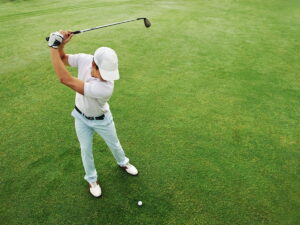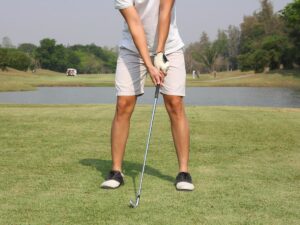
Hip Turn In The Golf Swing (The Key To More Power)
*This post may contain affiliate links. We are reader supported and earn affiliate commissions when you buy via links found on our site*

- Last Updated on
Contents
The amount of hip turn in the golf swing is one of the most important yet misunderstood parts of the game.
While professional golfers have mastered this move, most everyday golfers have not and it can kill the chances of grooving a consistent swing. Paired with the correct shoulder rotation tempo and a little practice, you can create a wildly consistent motion that is extremely dependable under pressure.
But if you’re like a lot of golfers I’m sure you have questions like:
- Do I turn my hips as much as my shoulders?
- Should I rotate my hips to start the downswing?
- How does weight transfer factor in on the backswing and downswing?
These are all great questions that we’ll address today so you finally understand the proper hip turn needed for a consistent swing.
Hip Turn in Golf Swing: The Key To Better Ball Striking
As I’m sure you know the golf swing is a complex motion with a lot of moving parts.
The hips in the golf swing, shoulders, arms, and hands all need to work together to get the club into a solid impact position. If one of these areas is out of sync, it’s easy to mishit a lot of shots.
Let’s first start by addressing what not to do with your hips – which is swaying laterally. This is a common move by amateur golfers but it can hurt distance and accuracy.
Stop Swaying
If you want to become a consistent ball striker it’s important to learn that you need to rotate, not slide your hips. This is what Tiger Woods said in his book, How I Play Golf, about avoiding lateral motion.
“Shifting your hips laterally to the right just kills your backswing. If your right hip moves outside of your right foot, you have to slide back to the left just to hit the ball.
What’s more, you’ve cut your power by about 50 percent, because a sliding motion on the downswing isn’t anywhere near as powerful as a rotary unwind of the hips and shoulders.”
Swaying your body back and forth is a formula for disaster as it makes your swing 100% built on timing. You might get away with this every once in a while, but if your tempo is off it’ll mess with everything.
Not to mention it makes it nearly impossible to clear your hips and generate power on the downswing. Build a swing with proper rotation (of both hips and shoulders) to become a solid ball striker.
Understand Shoulder vs. Hip Rotation
The second mistake a lot of golfers make is not understanding how the shoulders and hips work together.
The hips do not rotate as much as the shoulders. Golf Digest elaborated this point perfectly.
“This rotation of the shoulders and hips is so important because increasing both increases the two things players need to hit the ball far and straight: time and space. More turn translates into a wider, deeper backswing and more time to store power that can be released in the downswing.”
This is an important tip. If you constrict your turn, you’ll lose out on tons of power and speed. But more isn’t better – the key is to not try to keep moving your hips throughout the swing.
Instead, it’s about understanding the hips don’t rotate as much as the shoulders – it’s about half as much. Most PGA Tour players (and elite amateurs) have at least 90-degrees of shoulder turn. While their hip rotation is only a fraction of that – close to 45 degrees.

The Proper Hip Movement
So, how should the hips turn correctly in the golf swing?
It needs to happen in three parts – opening the hips during the takeaway, sliding hips toward the target, and opening hips at impact.
Follow this checklist to get your hips in the right position for a consistent sequence on every swing.
Get in the Right Posture
Before getting into how to turn your hips during the swing it’s important to get them in the right position at address. So many golf swing issues can be avoided by simply getting into a better posture and alignment. This means making sure your feet, hips, and shoulders are square to the target.
If you start the swing with one (or more) of these open or closed to your target, it’ll negatively impact your takeaway. This is why it’s a good idea to record your swing from both behind the ball and face on to evaluate your starting position. From one of these angles it’s easy to see if you’re not properly aligned.
Additionally, it’s a good idea to have some feet flare with both your left and right foot. Too many golfers don’t have any external flare and that leads to swaying vs. rotating.
Opening your feet externally makes it much easier to rotate and store power in your lower body. Make this subtle move with every club in the bag and you’ll see a huge difference in rotation and clearing your hips.
Understand the Takeaway
Once you’re in a good starting position, the next checkpoint is the takeaway. So much of the golf swing happens in the first part of the swing which can make or break the rest.
The shoulders start the backswing – not the hips. The shoulders, arms, and hands move before the hips to begin the takeaway. This is where weight starts to shift to your trail foot and hopefully keep the golf club on plane.
Once the club is parallel to the ground, then the hips begin to rotate. The key for amateur golfers is to make sure and rotate, not laterally sway to try and generate power.
Top of Backswing
The top of the backswing is a great place to evaluate your swing as this position sets up the downswing which happens in a flash. Try to feel as if the majority of your weight is on the inside of your trail foot (right foot for right-handed golfers) at the top of your swing.
This will ensure you don’t slide your hips and build a swing based on timing. Not to mention you’ll rotate more around your leg for even more power.
Starting the Downswing
The hips play a prominent role in starting the downswing and is another position that a lot of amateur golfers get wrong as they start the downswing by rotating the hips. While you need to rotate, you also need to slide and clear as well.
Michelle Wie said in a Golf.com article that swaying and not turning hips/shoulders properly is the biggest mistake she sees with amateur golfers. In the article she elaborated saying,
“If you focus solely on turning your hips and shoulders around your spine, you’ll risk spinning out of the shot, which saps you of power and consistency. Instead, you have to combine your turn with the right amount of weight shift if you want to get the best results.”
You need to open (also known as clear your hips) while simultaneously shifting your weight to your lead leg.
If you simply open your hips from the top of your backswing without transferring your weight you’ll spin out of the shot as Michelle mentioned. This will lead to a lot of mishits, blocks, and weak slices that make it hard to shoot your best scores.
Instead, feel like you’re pressing off your lead foot into the ground while opening your hips.
This will ensure you use the ground to push off and clear your hips at the same time. This is known as “bumping” your hips forward and can even happen while the backswing is being completed.
When done in the correct sequence it has the potential to take your game to the next level. This will help create forward shaft lean which is key for well struck irons and wedges. It’ll also use your legs which have tons of power to generate more speed and distance with every club in the bag.
Impact
The final checkpoint to evaluate your hip position is impact – aka the moment of truth. If you’ve avoided swaying and transferred your weight properly, impact should be solid.
The key is to make sure and continue rotating as you hit the ball and swing through the shot. This is referred to as clearing your hips and getting them out of the way for your upper body to shallow out and square the clubface.
The finished product should result in a balanced follow through with your hips facing the target. A good swing thought is to “get your belt buckle facing the target” for proper hip rotation in the downswing.
Hip Rotation Drills
There are tons of videos on hip rotation drills on YouTube but here are two simple ways to learn how to use your hips properly.
Chair Drill
To feel the proper hip rotation check out this popular video from Clay Ballard at Top Speed Golf. As he mentioned in the video it’s important to feel like you sit down to start your backswing. This will help avoid early rotation, create lag, and use your hips to generate power.
Too many golfers raise up and move their pelvis to the ball which makes it nearly impossible to unwind the hips properly. Stay in your posture throughout the swing for more consistent ball striking.
Anti-Sway Drill
As noted above, swaying is a power killer in the golf swing. To avoid swaying take a small golf bag on the range (the one the balls are usually in) or a golf club stand. Lean it against your trail hip during the swing.
Take 5-10 practice swings without bumping the stand or bag on your backswing. When you don’t sway on the backswing it’ll make it much easier to get into the proper position on the downswing. Having a stand or bag next to you can provide immediate feedback and stop you from swaying.
Top Questions About Hip Turn
If you want to learn even more about how the hips impact your golf swing, keep reading through our top questions and answers now.
How do you turn your hips in the golf downswing?
Your hips are the driving force of your downswing. Players should strive to open their hips while pressing down their lead leg to get the proper weight transfer and rotate through the shot.
If you struggle with hip rotation it’s also important to work on flexibility. If your hips are too tight it can make it hard to turn properly and limit rotation. Make sure to stretch, foam roll, and get body work done (like massage and chiropractic) to avoid injuries and improve rotation.
Can you have too much hip turn in the golf swing?
Yes, it’s possible to have too much hip turn which actually hurts your swing. It’s better to have more shoulder rotation than hip rotation in the golf swing.
When you keep hip rotation to around 45 degrees it makes it easier to open your hips on the downswing. This will lead to a better impact position and dramatically better ball striking.
Do the hips turn level in the backswing?
The hips should turn pretty level during the swing but it’s okay if the right hip drops slightly. This makes it easier to load up power on your back leg to then unload on the downswing.
Do your arms or hips start the backswing?
Arms and shoulders are the primary movers during the initial part of the backswing. The hips will follow and turn about half as much as the shoulders.
Do hips move in the takeaway?
The hips move at the end of the takeaway but not initially when the club is taken back from the golf ball. Too many players rotate their hips too early which throws off tempo and timing. The hips play a much bigger role in the downswing as they unwind and help generate power.
Wrapping Up
The hips are an important part of the swing but more turn isn’t always better. As instructor Luke Kerr Dineen said in Golf.com.
“The ability to separate your hips from your shoulders is an important trait of good golf swings. Turning your hips and shoulders too much together tends to drag the club over the top and result in big slices. So, while hip turn is good (and powerful!) too much of it too soon can cause issues.”
If you’re struggling with proper hip motion make sure to look at your starting position first. Then determine where the breakdown is occurring – whether it’s your takeaway, backswing, or downswing.
When you avoid swaying and focus on rotating your hips, a ton of swing issues will get fixed immediately.
What’s your favorite hip rotation drill?
Let us know in the comments below.

Michael Leonard
Michael Leonard is a full-time writer, author, creator of Wicked Smart Golf and +1 handicap amateur golfer. He left his corporate career in 2017 to pursue entrepreneurship and professional golf; since then, he’s competed in 160+ tournament days and went to Q-school in 2019.





